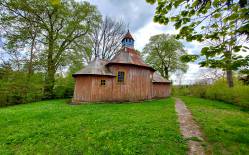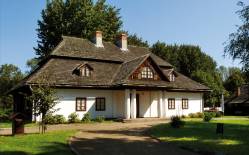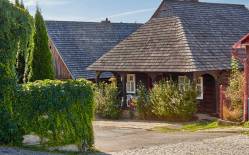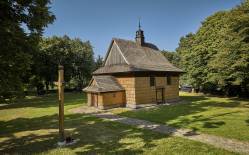The location of parish church of St. Mary Magdalene supposedly was earlier occupied by a wooden fortified castle. A parish was established here in 1384. The church additionally functioned as a refuge making it possible to resist small groups of armed Tatars or robbers. Over time the earthen and wooden defensive structures were modernised.
The log church is oriented eastward. It comprises a chancel, enclosed with semi-hexagonal walls and a rectangular nave. Underneath the chancel there is a burial vault, and on the northern side it is adjoined by a sacristy. On the western side of the nave, we can see a post-and-beam tower with a chamber in the upper part and with a brick vestibule on the ground floor. A broad skirt roof runs along the outer walls of the chancel and both sides of the nave. The gable roof over the nave is clad with shingles, and on the ridge we can see a bell turret. The tower with the chamber is covered with a two-tiered hip roof. The doors leading from the chancel to the sacristy, with hinges and a lock, presumably date from the 1600s. Inside there is a flat ceiling, and the span of the structure is divided by wooden columns.
The walls and the ceiling are ornamented with polychrome paintings from the 1800s. The high altar holds a painting of St. Mary Magdalene, and the left-side altar features pictures of the Holy Mother and the Child (probably from the 1500s) and St. Joseph (from the 1700s). There are also interesting rococo procession floats from the 1700s, and two Gothic oak chests with iron fittings, from the late 16th/early 17th century.
In 1936 a mound was built in honour of Michał Pyrz, the village leader. The ceremony of the blessing of the mound was attended by Supreme Commander of Polish Armed Forces – Edward Rydz Śmigły.
Relics of a late-Lusatian cremation cemetery (700–900) were unearthed in the village.
There is also the so-called Holy Lake, where according to a legend, stood a pagan temple; numerous metal artefacts found here bear witness to this claim.
Photo: Krystian Kłysewicz
Gallery
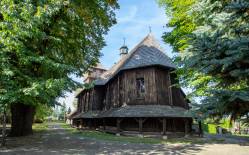
Recommended venues on the Trail



This website has been modernized with the financial support of the European Union under the Cross-Border Cooperation Programme Poland-Belarus-Ukraine 2014-2020. The responsibility for its content lies solely with the Podkarpackie Regional Tourism Board and cannot, in any case, be treated as a reflection of the position of the European Union, the Managing Authority, or the Joint Technical Secretariat of the Cross-Border Cooperation Programme Poland-Belarus-Ukraine 2014-2020.










